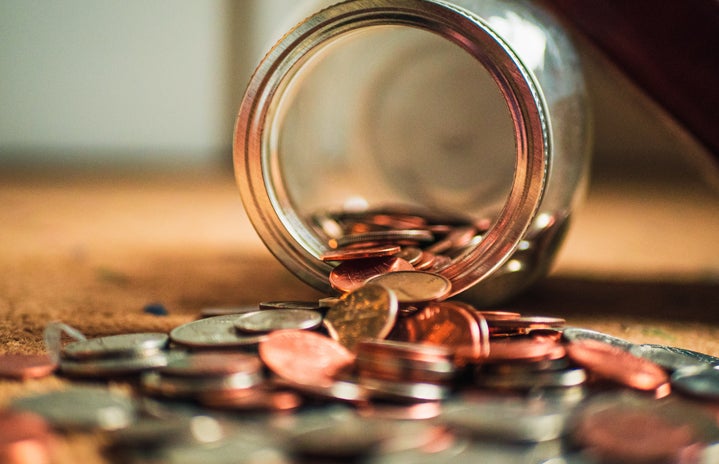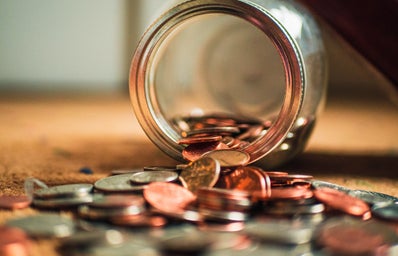College. To sum it up:
Need I say more?
I’m sure you’ve heard all about saving money, prioritizing, being smart, and so on, but have you actually done it? Have you really taken it seriously? I know I didn’t. I have an online banking app and, when I got my general statement on my spending for the month of December, I had a heart attack. I knew it was the holidays and I spent money on gifts, but I certainly didn’t spend $600 worth. I spent around $150 on gifts and $100 on gas, so where did the other $350 go? I scrolled through that long, devastating list of purchases and found that $350 went towards tons of small, unnecessary purchases, mostly under $5 each. From snacks, to meals, gum, drinks, coffee, and beauty products that I didn’t actually need, it added up to over $350 for only one moth. I decided I needed to kick it into gear, and you should too.
Most people don’t realize the toll those many small purchases take on your account, slowly sucking out your funds little by little over time. I bet if you were to look at the history of your transactions, you would be just as scared. So here’s a list of things you can do to create healthier spending habits. Help cushion your account from the burden of debt and save your future by thinking long term.
1. Budget
Budgeting is an excellent way to save money. You can budget in all kinds of ways, from simple to extreme. For starters, you can put a certain amount of money into multiple envelopes, labeling each one of them what you’d spend money on. For example, you could label an envelope that says gas and put $20 in it, one that says food with $15, etc. You can do this weekly, not allowing yourself to spend more than the amount of money you gave yourself. You could also be much more serious and budget by only allowing yourself to spend $20 a week on things that aren’t necessary at all, whether it’s going to the bar, going out to eat, seeing a movie, or anything else. We don’t usually lose our money on the big purchases, because we tend to know better than to randomly splurge and spend $100 on a cute pair of boots we don’t need. We usually lose our money on the small ones, the quick Starbuck’s run and the extra mascara buy. So be smart and budget. Know your limits, your necessities, and your account.
2. Think Twice
Learn when to say “no.” Yes, it’s fun to go out and grab a bite with friends. Yes, it’s nice to buy an expensive shirt that’s unique and “so you.” Yes, it’s exciting to go to Regal Cinemas. But is it essential? It’s okay to do these things once in a while. I’m not telling you to sacrifice fun. I’m just telling you to think twice about it. How often do you do it? When did you do it last? How much money do you have? What do you have to spend the money on? What could you do instead that’s cheaper or free? All of these things are questions you should ask yourself when getting ready to make an unnecessary purchase. Think about how important it is and the impact it’ll have on your account, long term. It’s easy to say “no” to a good time to have an even better time in the future or in the moment, but for free.
3. Buy Bulk
Food is a major problem for people when it comes to money. First things first, if you have a meal plan, use it. I get Saga doesn’t have great food and Casey’s is old, but those are really just excuses to get you to go out and spend money you don’t have. I have eaten at both places many times, and it’s not bad at all. There are so many different selections and options. Get creative! And you don’t always have to use your meal plans either, so buy in bulk! This means buy food items that you can cook on your own. Make dinner for your housemates or pack a lunch. Buying food that’ll last a while saves so much money in the long run, it’s unbelievable. Why spend $10 to $15 per meal when you can spend less than that on spices, carbs, meats, cheeses, and vegetables that’ll last you five meals?
4. Carpool
Gas. It’s a serious driving issue. No one wants to use it, because no one wants to buy it. So, easy solution? Carpool. Have you and your friends switch on and off with driving duty. Instead of all meeting up at a place, drive together, or at least meet somewhere closer. Carpooling can sometimes cut gas expenses in more than half. And better yet, just don’t drive. Siena isn’t far away from a plaza, so walk or ride a bike! In the colder weather, just stay on campus. There are plenty of activities to do and events to attend, so save your gas for just another night. It’ll do much more good than harm.
5. DIY
Stop buying, buying, buying and start doing, doing, doing. Of course it’ll require more time, effort, and, need I say it, work, but it’ll always be worth it in the end. Do-it-yourself activities are the best and most fun ways of saving money, from making presents for people to cooking food. You don’t have to buy everything you need; you can always get creative. Of course this doesn’t apply to everything, but it applies to more than you know, you just have to think outside of the box. It can even go as far as growing your own tomatoes in a little pot on your windowsill. I’ve seen plenty of people do this, and they always love it.
Spending money is certainly a universal problem amongst college students, but it doesn’t have to be. It’s up to you to know your limits. You need to budget, think twice, buy in bulk, carpool, and DIY. What’s in your wallet?

